Cut off FIAT BARCHETTA 2003 1.G Owners Manual
[x] Cancel search | Manufacturer: FIAT, Model Year: 2003, Model line: BARCHETTA, Model: FIAT BARCHETTA 2003 1.GPages: 170, PDF Size: 3.55 MB
Page 10 of 170
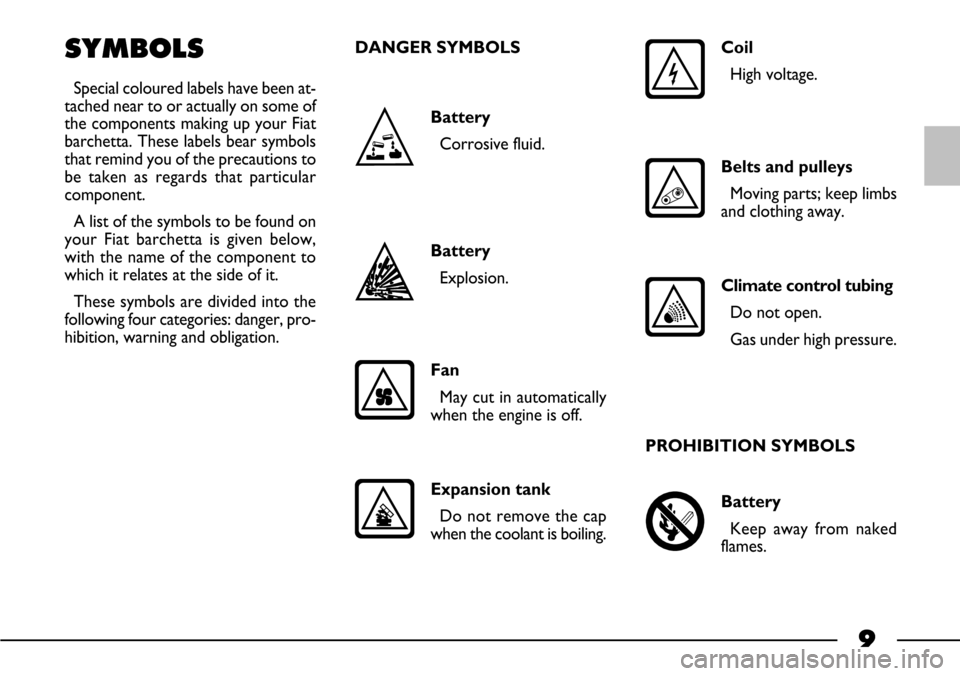
Climate control tubing
Do not open.
Gas under high pressure. Belts and pulleys
Moving parts; keep limbs
and clothing away. Coil
High voltage.
9
SYMBOLS
Special coloured labels have been at-
tached near to or actually on some of
the components making up your Fiat
barchetta. These labels bear symbols
that remind you of the precautions to
be taken as regards that particular
component.
A list of the symbols to be found on
your Fiat barchetta is given below,
with the name of the component to
which it relates at the side of it.
These symbols are divided into the
following four categories: danger, pro-
hibition, warning and obligation.DANGER SYMBOLS
Battery
Corrosive fluid.
Battery
Explosion.
Fan
May cut in automatically
when the engine is off.
Expansion tank
Do not remove the cap
when the coolant is boiling.
Battery
Keep away from naked
flames.
PROHIBITION SYMBOLS
Page 17 of 170
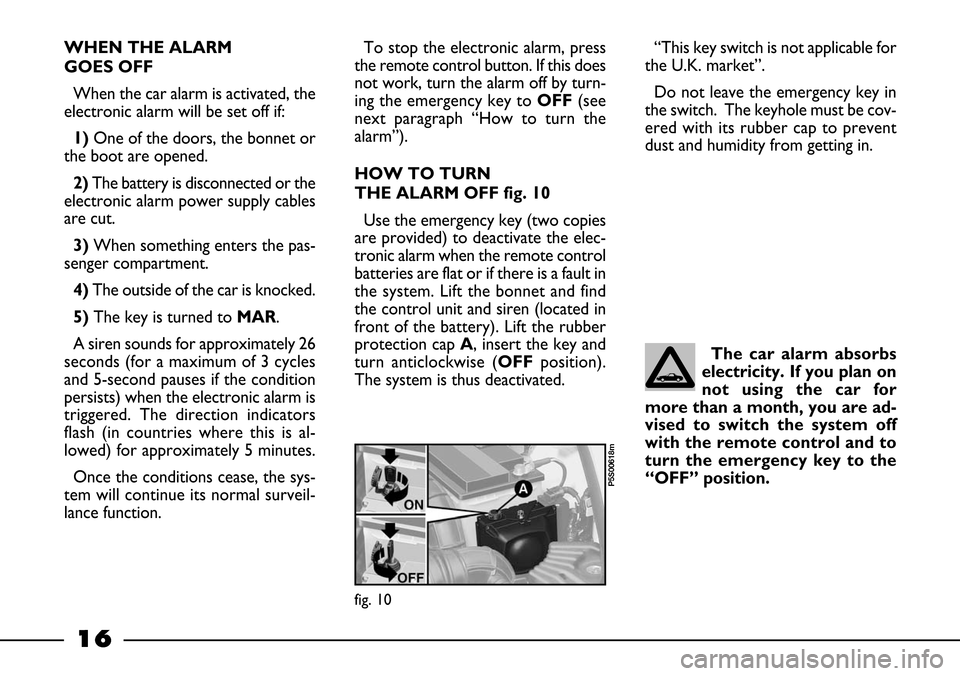
The car alarm absorbs
electricity. If you plan on
not using the car for
more than a month, you are ad-
vised to switch the system off
with the remote control and to
turn the emergency key to the
“OFF” position.
16
WHEN THE ALARM
GOES OFF
When the car alarm is activated, the
electronic alarm will be set off if:
1)One of the doors, the bonnet or
the boot are opened.
2)The battery is disconnected or the
electronic alarm power supply cables
are cut.
3) When something enters the pas-
senger compartment.
4)The outside of the car is knocked.
5)The key is turned to MAR.
A siren sounds for approximately 26
seconds (for a maximum of 3 cycles
and 5-second pauses if the condition
persists) when the electronic alarm is
triggered. The direction indicators
flash (in countries where this is al-
lowed) for approximately 5 minutes.
Once the conditions cease, the sys-
tem will continue its normal surveil-
lance function.To stop the electronic alarm, press
the remote control button. If this does
not work, turn the alarm off by turn-
ing the emergency key toOFF(see
next paragraph “How to turn the
alarm”).
HOW TO TURN
THE ALARM OFF fig. 10
Use the emergency key (two copies
are provided) to deactivate the elec-
tronic alarm when the remote control
batteries are flat or if there is a fault in
the system. Lift the bonnet and find
the control unit and siren (located in
front of the battery). Lift the rubber
protection cap A, insert the key and
turn anticlockwise (OFFposition).
The system is thus deactivated.“This key switch is not applicable for
the U.K. market”.
Do not leave the emergency key in
the switch. The keyhole must be cov-
ered with its rubber cap to prevent
dust and humidity from getting in.
fig. 10
P5S00618m
Page 18 of 170
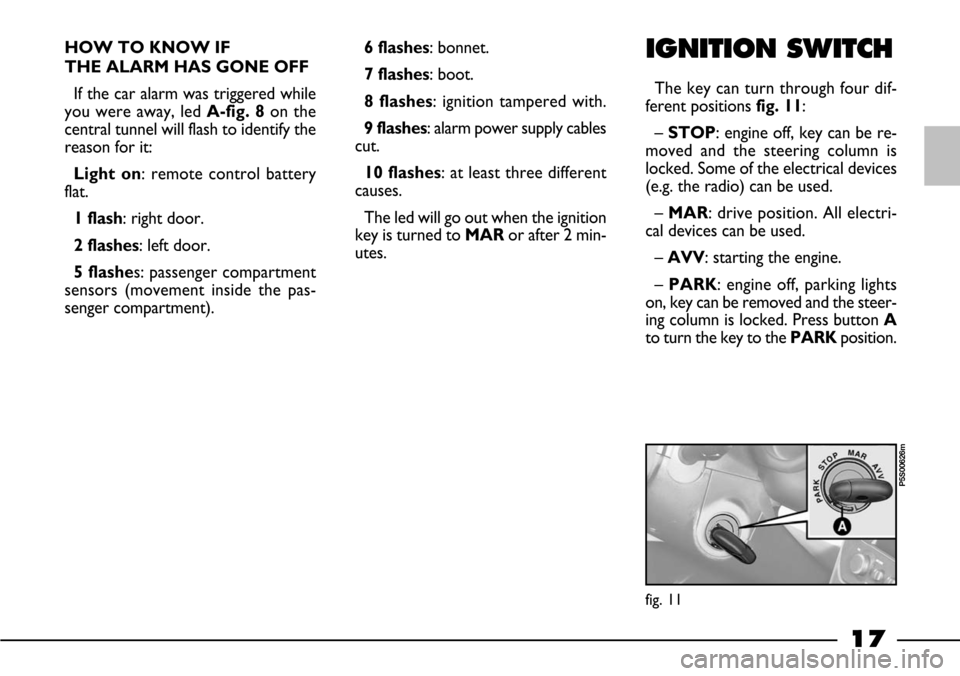
17
HOW TO KNOW IF
THE ALARM HAS GONE OFF
If the car alarm was triggered while
you were away, led A-fig. 8on the
central tunnel will flash to identify the
reason for it:
Light on: remote control battery
flat.
1 flash: right door.
2 flashes: left door.
5 flashes: passenger compartment
sensors (movement inside the pas-
senger compartment).6 flashes: bonnet.
7 flashes: boot.
8 flashes: ignition tampered with.
9 flashes: alarm power supply cables
cut.
10 flashes: at least three different
causes.
The led will go out when the ignition
key is turned toMARor after 2 min-
utes.IGNITION SWITCH
The key can turn through four dif-
ferent positions fig. 11:
– STOP: engine off, key can be re-
moved and the steering column is
locked. Some of the electrical devices
(e.g. the radio) can be used.
– MAR: drive position. All electri-
cal devices can be used.
– AVV: starting the engine.
– PARK: engine off, parking lights
on, key can be removed and the steer-
ing column is locked. Press button A
to turn the key to the PARKposition.
fig. 11
P5S00626m
Page 29 of 170
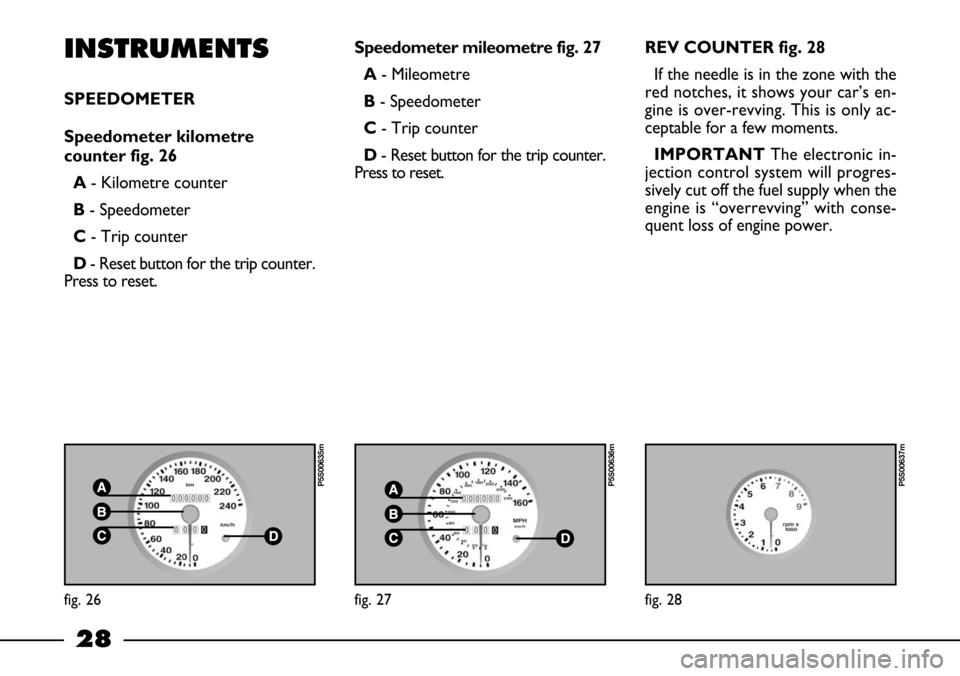
28
INSTRUMENTS
SPEEDOMETER
Speedometer kilometre
counter fig. 26
A- Kilometre counter
B- Speedometer
C- Trip counter
D- Reset button for the trip counter.
Press to reset.Speedometer mileometre fig. 27
A- Mileometre
B- Speedometer
C- Trip counter
D- Reset button for the trip counter.
Press to reset.REV COUNTER fig. 28
If the needle is in the zone with the
red notches, it shows your car’s en-
gine is over-revving. This is only ac-
ceptable for a few moments.
IMPORTANT The electronic in-
jection control system will progres-
sively cut off the fuel supply when the
engine is “overrevving” with conse-
quent loss of engine power.
fig. 26
P5S00635m
fig. 27
P5S00636m
fig. 28
P5S00637m
Page 42 of 170
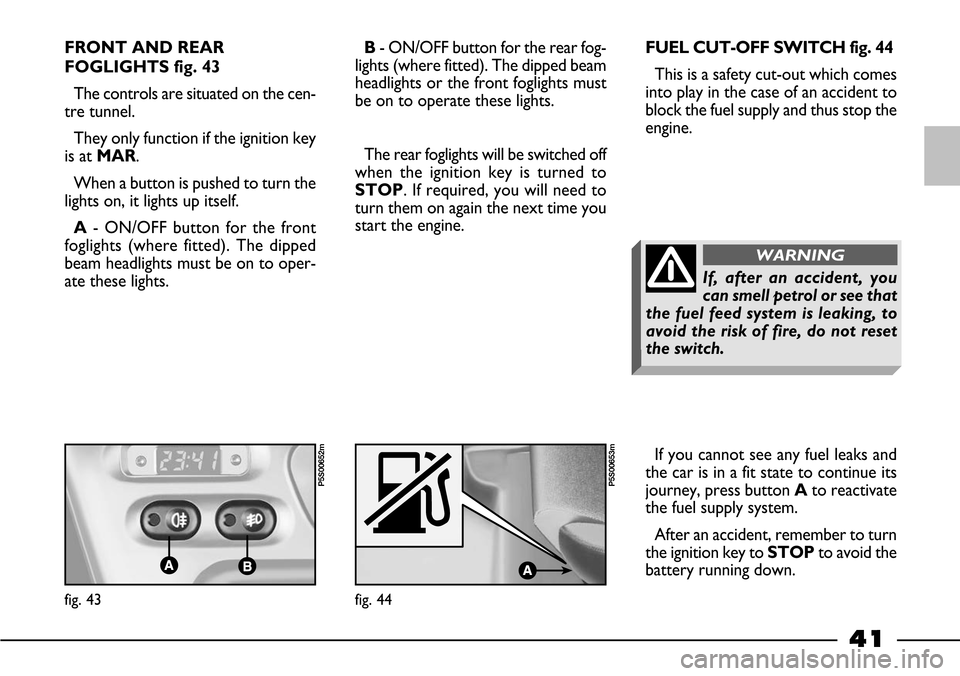
41
FRONT AND REAR
FOGLIGHTS fig. 43
The controls are situated on the cen-
tre tunnel.
They only function if the ignition key
is at MAR.
When a button is pushed to turn the
lights on, it lights up itself.
A- ON/OFF button for the front
foglights (where fitted). The dipped
beam headlights must be on to oper-
ate these lights.B- ON/OFF button for the rear fog-
lights (where fitted). The dipped beam
headlights or the front foglights must
be on to operate these lights.
The rear foglights will be switched off
when the ignition key is turned to
STOP. If required, you will need to
turn them on again the next time you
start the engine.FUEL CUT-OFF SWITCH fig. 44
This is a safety cut-out which comes
into play in the case of an accident to
block the fuel supply and thus stop the
engine.
If you cannot see any fuel leaks and
the car is in a fit state to continue its
journey, press button Ato reactivate
the fuel supply system.
After an accident, remember to turn
the ignition key toSTOPto avoid the
battery running down.
fig. 44
P5S00653m
fig. 43
P5S00652m
If, after an accident, you
can smell petrol or see that
the fuel feed system is leaking, to
avoid the risk of fire, do not reset
the switch.
WARNING
Page 57 of 170
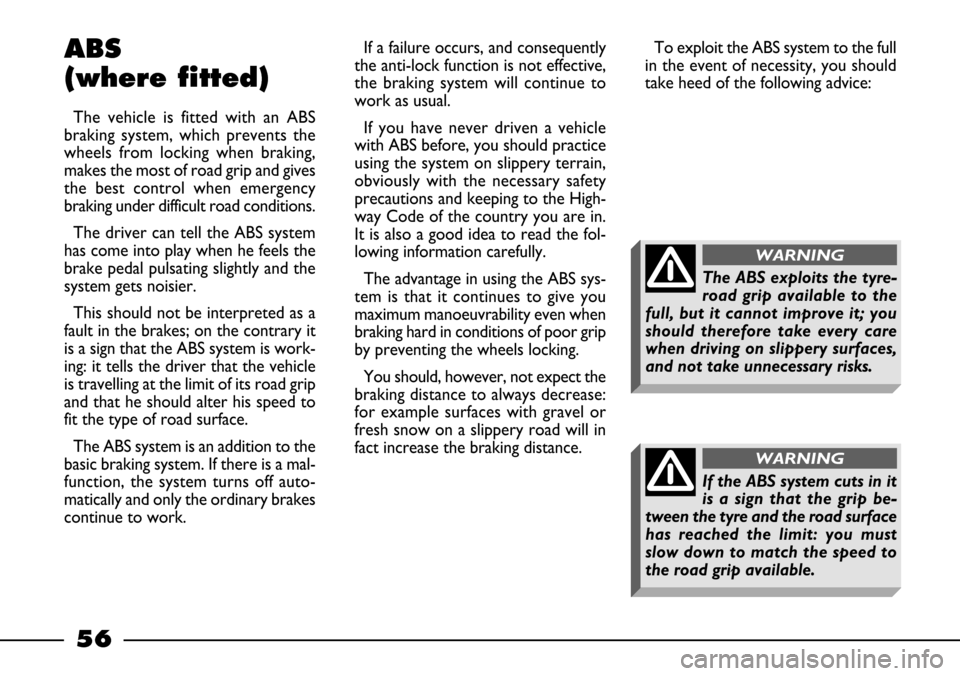
56
ABS
(where fitted)
The vehicle is fitted with an ABS
braking system, which prevents the
wheels from locking when braking,
makes the most of road grip and gives
the best control when emergency
braking under difficult road conditions.
The driver can tell the ABS system
has come into play when he feels the
brake pedal pulsating slightly and the
system gets noisier.
This should not be interpreted as a
fault in the brakes; on the contrary it
is a sign that the ABS system is work-
ing: it tells the driver that the vehicle
is travelling at the limit of its road grip
and that he should alter his speed to
fit the type of road surface.
The ABS system is an addition to the
basic braking system. If there is a mal-
function, the system turns off auto-
matically and only the ordinary brakes
continue to work.If a failure occurs, and consequently
the anti-lock function is not effective,
the braking system will continue to
work as usual.
If you have never driven a vehicle
with ABS before, you should practice
using the system on slippery terrain,
obviously with the necessary safety
precautions and keeping to the High-
way Code of the country you are in.
It is also a good idea to read the fol-
lowing information carefully.
The advantage in using the ABS sys-
tem is that it continues to give you
maximum manoeuvrability even when
braking hard in conditions of poor grip
by preventing the wheels locking.
You should, however, not expect the
braking distance to always decrease:
for example surfaces with gravel or
fresh snow on a slippery road will in
fact increase the braking distance.To exploit the ABS system to the full
in the event of necessity, you should
take heed of the following advice:
The ABS exploits the tyre-
road grip available to the
full, but it cannot improve it; you
should therefore take every care
when driving on slippery surfaces,
and not take unnecessary risks.
WARNING
If the ABS system cuts in it
is a sign that the grip be-
tween the tyre and the road surface
has reached the limit: you must
slow down to match the speed to
the road grip available.
WARNING
Page 76 of 170
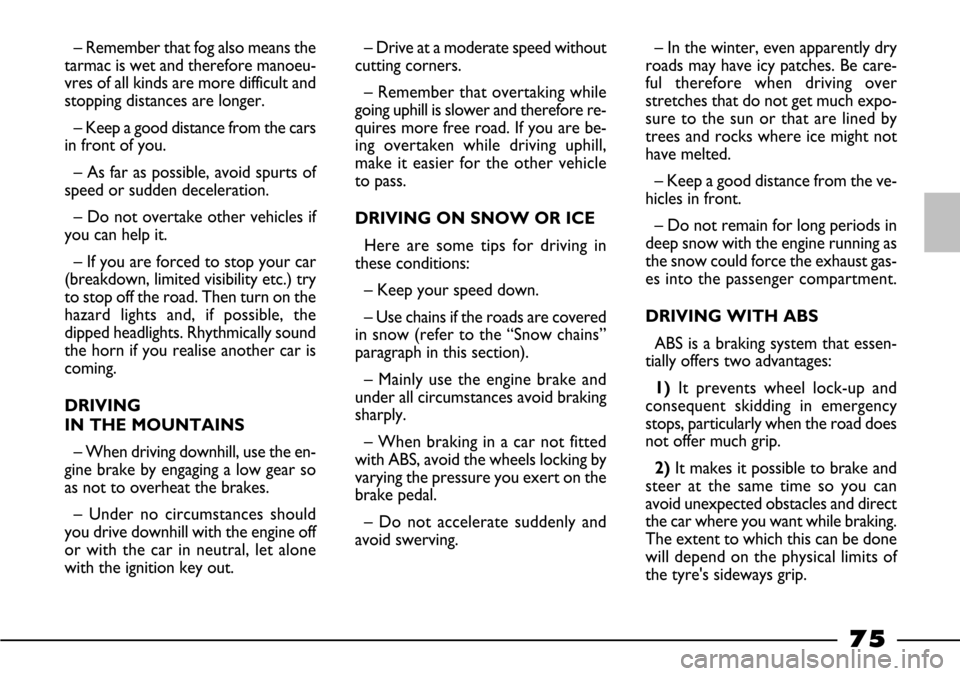
75
– Remember that fog also means the
tarmac is wet and therefore manoeu-
vres of all kinds are more difficult and
stopping distances are longer.
– Keep a good distance from the cars
in front of you.
– As far as possible, avoid spurts of
speed or sudden deceleration.
– Do not overtake other vehicles if
you can help it.
– If you are forced to stop your car
(breakdown, limited visibility etc.) try
to stop off the road. Then turn on the
hazard lights and, if possible, the
dipped headlights. Rhythmically sound
the horn if you realise another car is
coming.
DRIVING
IN THE MOUNTAINS
– When driving downhill, use the en-
gine brake by engaging a low gear so
as not to overheat the brakes.
– Under no circumstances should
you drive downhill with the engine off
or with the car in neutral, let alone
with the ignition key out.– Drive at a moderate speed without
cutting corners.
– Remember that overtaking while
going uphill is slower and therefore re-
quires more free road. If you are be-
ing overtaken while driving uphill,
make it easier for the other vehicle
to pass.
DRIVING ON SNOW OR ICE
Here are some tips for driving in
these conditions:
– Keep your speed down.
– Use chains if the roads are covered
in snow (refer to the “Snow chains”
paragraph in this section).
– Mainly use the engine brake and
under all circumstances avoid braking
sharply.
– When braking in a car not fitted
with ABS, avoid the wheels locking by
varying the pressure you exert on the
brake pedal.
– Do not accelerate suddenly and
avoid swerving.– In the winter, even apparently dry
roads may have icy patches. Be care-
ful therefore when driving over
stretches that do not get much expo-
sure to the sun or that are lined by
trees and rocks where ice might not
have melted.
– Keep a good distance from the ve-
hicles in front.
– Do not remain for long periods in
deep snow with the engine running as
the snow could force the exhaust gas-
es into the passenger compartment.
DRIVING WITH ABS
ABS is a braking system that essen-
tially offers two advantages:
1)It prevents wheel lock-up and
consequent skidding in emergency
stops, particularly when the road does
not offer much grip.
2)It makes it possible to brake and
steer at the same time so you can
avoid unexpected obstacles and direct
the car where you want while braking.
The extent to which this can be done
will depend on the physical limits of
the tyre's sideways grip.
Page 79 of 170
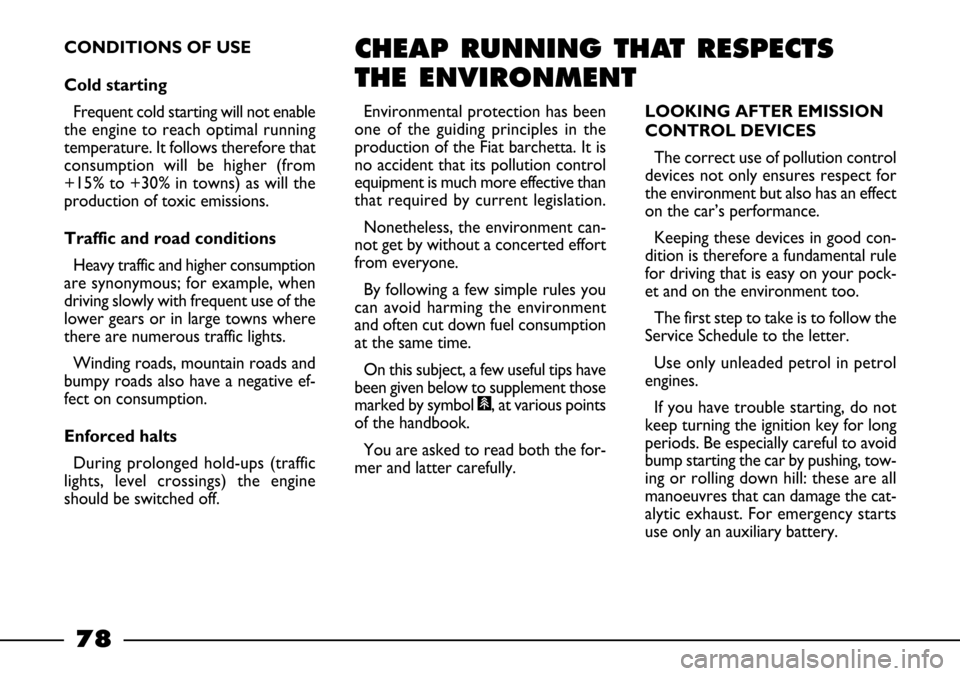
78
CONDITIONS OF USE
Cold starting
Frequent cold starting will not enable
the engine to reach optimal running
temperature. It follows therefore that
consumption will be higher (from
+15% to +30% in towns) as will the
production of toxic emissions.
Traffic and road conditions
Heavy traffic and higher consumption
are synonymous; for example, when
driving slowly with frequent use of the
lower gears or in large towns where
there are numerous traffic lights.
Winding roads, mountain roads and
bumpy roads also have a negative ef-
fect on consumption.
Enforced halts
During prolonged hold-ups (traffic
lights, level crossings) the engine
should be switched off.CHEAP RUNNING THAT RESPECTS
THE ENVIRONMENT
LOOKING AFTER EMISSION
CONTROL DEVICES
The correct use of pollution control
devices not only ensures respect for
the environment but also has an effect
on the car’s performance.
Keeping these devices in good con-
dition is therefore a fundamental rule
for driving that is easy on your pock-
et and on the environment too.
The first step to take is to follow the
Service Schedule to the letter.
Use only unleaded petrol in petrol
engines.
If you have trouble starting, do not
keep turning the ignition key for long
periods. Be especially careful to avoid
bump starting the car by pushing, tow-
ing or rolling down hill: these are all
manoeuvres that can damage the cat-
alytic exhaust. For emergency starts
use only an auxiliary battery. Environmental protection has been
one of the guiding principles in the
production of the Fiat barchetta. It is
no accident that its pollution control
equipment is much more effective than
that required by current legislation.
Nonetheless, the environment can-
not get by without a concerted effort
from everyone.
By following a few simple rules you
can avoid harming the environment
and often cut down fuel consumption
at the same time.
On this subject, a few useful tips have
been given below to supplement those
marked by symbol #, at various points
of the handbook.
You are asked to read both the for-
mer and latter carefully.
Page 110 of 170
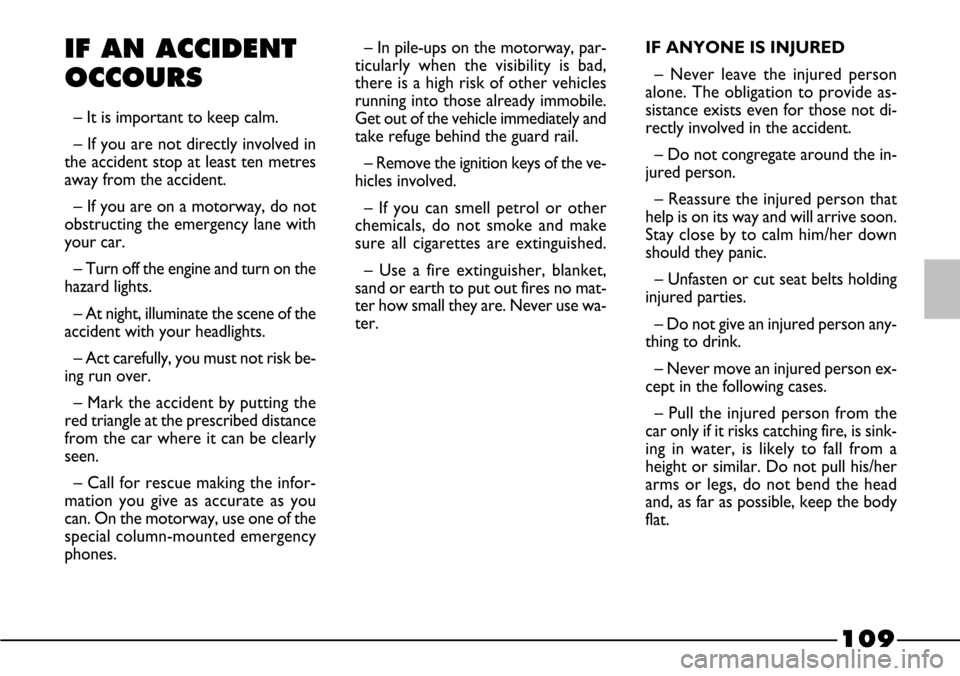
109
IF AN ACCIDENT
OCCOURS
– It is important to keep calm.
– If you are not directly involved in
the accident stop at least ten metres
away from the accident.
– If you are on a motorway, do not
obstructing the emergency lane with
your car.
– Turn off the engine and turn on the
hazard lights.
– At night, illuminate the scene of the
accident with your headlights.
– Act carefully, you must not risk be-
ing run over.
– Mark the accident by putting the
red triangle at the prescribed distance
from the car where it can be clearly
seen.
– Call for rescue making the infor-
mation you give as accurate as you
can. On the motorway, use one of the
special column-mounted emergency
phones.– In pile-ups on the motorway, par-
ticularly when the visibility is bad,
there is a high risk of other vehicles
running into those already immobile.
Get out of the vehicle immediately and
take refuge behind the guard rail.
– Remove the ignition keys of the ve-
hicles involved.
– If you can smell petrol or other
chemicals, do not smoke and make
sure all cigarettes are extinguished.
– Use a fire extinguisher, blanket,
sand or earth to put out fires no mat-
ter how small they are. Never use wa-
ter.IF ANYONE IS INJURED
– Never leave the injured person
alone. The obligation to provide as-
sistance exists even for those not di-
rectly involved in the accident.
– Do not congregate around the in-
jured person.
– Reassure the injured person that
help is on its way and will arrive soon.
Stay close by to calm him/her down
should they panic.
– Unfasten or cut seat belts holding
injured parties.
– Do not give an injured person any-
thing to drink.
– Never move an injured person ex-
cept in the following cases.
– Pull the injured person from the
car only if it risks catching fire, is sink-
ing in water, is likely to fall from a
height or similar. Do not pull his/her
arms or legs, do not bend the head
and, as far as possible, keep the body
flat.
Page 161 of 170
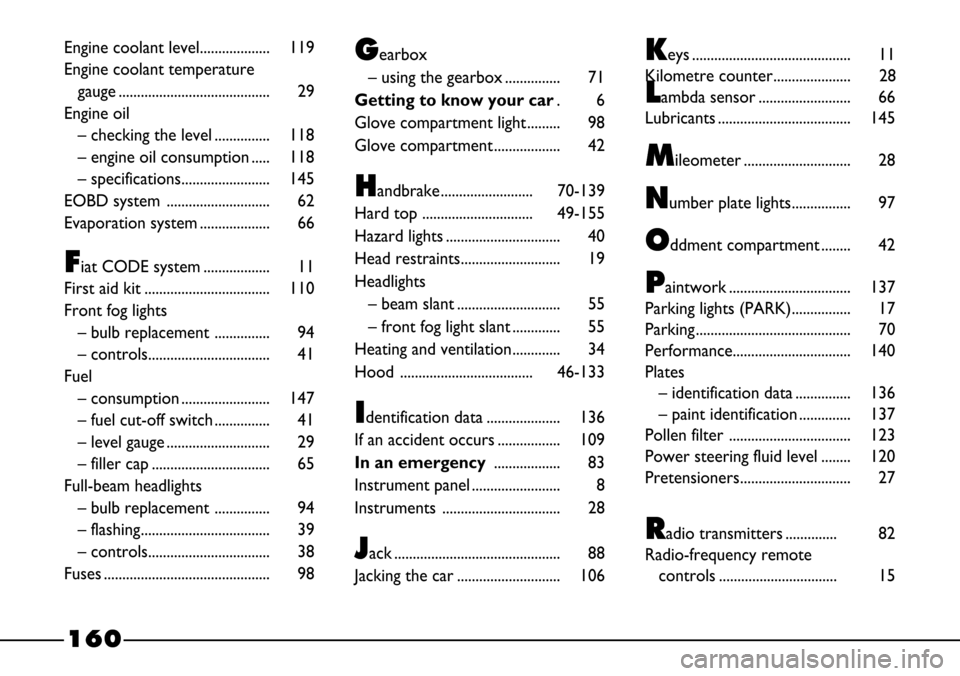
160
Engine coolant level................... 119
Engine coolant temperature
gauge ......................................... 29
Engine oil
– checking the level ............... 118
– engine oil consumption ..... 118
– specifications........................ 145
EOBD system ............................ 62
Evaporation system ................... 66
Fiat CODE system .................. 11
First aid kit .................................. 110
Front fog lights
– bulb replacement ............... 94
– controls................................. 41
Fuel
– consumption ........................ 147
– fuel cut-off switch ............... 41
– level gauge ............................ 29
– filler cap ................................ 65
Full-beam headlights
– bulb replacement ............... 94
– flashing................................... 39
– controls................................. 38
Fuses ............................................. 98
Gearbox
– using the gearbox ............... 71
Getting to know your car.6
Glove compartment light ......... 98
Glove compartment .................. 42
Handbrake......................... 70-139
Hard top .............................. 49-155
Hazard lights ............................... 40
Head restraints........................... 19
Headlights
– beam slant ............................ 55
– front fog light slant ............. 55
Heating and ventilation............. 34
Hood .................................... 46-133
Identification data .................... 136
If an accident occurs ................. 109
In an emergency.................. 83
Instrument panel ........................ 8
Instruments ................................ 28
Jack ............................................. 88
Jacking the car ............................ 106
Keys ........................................... 11
Kilometre counter..................... 28
Lambda sensor ......................... 66
Lubricants .................................... 145
Mileometer ............................. 28
Number plate lights................ 97
Oddment compartment ........ 42
Paintwork ................................. 137
Parking lights (PARK)................ 17
Parking .......................................... 70
Performance................................ 140
Plates
– identification data ............... 136
– paint identification .............. 137
Pollen filter ................................. 123
Power steering fluid level ........ 120
Pretensioners.............................. 27
Radio transmitters .............. 82
Radio-frequency remote
controls ................................ 15